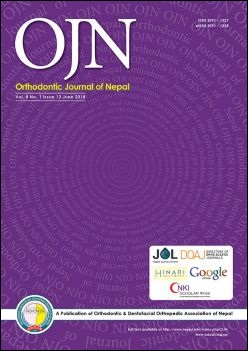Assessment of Knowledge on Key Features of Angle’s Class II Division 1 Malocclusion among Dental School Under-graduates
DOI:
https://doi.org/10.3126/ojn.v8i1.21346Keywords:
Angle’s Classification, Knowledge, malocclusion, orthodontic treatmentAbstract
Introduction: Angle in 1899 propounded the classification to recognize the malocclusion patterns. Class II Division 1 is a malalignment which can be identified by the parameters mentioned.
Objective: To assess the knowledge of dental undergraduate students about Class II Division 1 malocclusion and their opinion about the treatment or clinical approach to such patients. Materials & Method: The study was performed using closed questionnaire on 138 fourth and final year undergraduate dental students of College of Dental Sciences, Bharatpur, Nepal. Dental casts and photographs of a patient with Class II Division 1 were shown to the respondents to depict deviated midline, midline diastema, molar relation, increased overjet and overbite.
Result: Dental students found it easy to identify increased overjet (91.99%), increased overbite (88.78%), presence of diastema (84.69%) and midline deviation (77.28%). However, 52% students could not identify the molar relationship. When asked about the appropriate timing for treatment; 48.8% thought it should be in deciduous dentition period, 41.6% in mixed dentition, and 9.6% in permanent dentition.
Conclusion: Fourth and final year BDS students possess fair knowledge on common parameters used to determine Class II Division 1 malocclusion but they find difficulties in compiling and applying this knowledge to orthodontic treatment concept.
Downloads
Downloads
Published
How to Cite
Issue
Section
License
Copyright © held by Orthodontic & Dentofacial Orthopedic Association of Nepal
- Copyright on any research article is transferred in full to the Orthodontic & Dentofacial Orthopedic Association of Nepal upon publication in the journal. The copyright transfer includes the right to reproduce and distribute the article in any form of reproduction (printing, electronic media or any other form).
- Articles in the Orthodontic Journal of Nepal are Open Access articles published under the Creative Commons CC BY License (https://creativecommons.org/licenses/by/4.0/)
- This license permits use, distribution and reproduction in any medium, provided the original work is properly cited.




